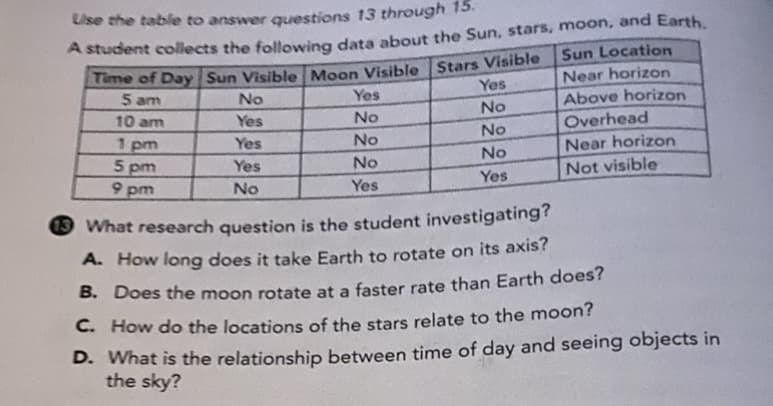UUse the table to answer questions T13 A student collects the following data about the Sun, stars, moon, and Earth. Sun Location Near horizon Above horizon Overhead Near horizon Time of Day Sun Visible Moon Visible Stars Visible 5 am Yes No Yes No 10 am Yes No No 1 pm 5 pm 9 pm Yes No No Yes No Yes Not visible No Yes O What research question is the student investigating? A. How long does it take Earth to rotate on its axis? B. Does the moon rotate at a faster rate than Earth does? C. How do the locations of the stars relate to the moon? D. What is the relationship between time of day and seeing objects in the sky?
UUse the table to answer questions T13 A student collects the following data about the Sun, stars, moon, and Earth. Sun Location Near horizon Above horizon Overhead Near horizon Time of Day Sun Visible Moon Visible Stars Visible 5 am Yes No Yes No 10 am Yes No No 1 pm 5 pm 9 pm Yes No No Yes No Yes Not visible No Yes O What research question is the student investigating? A. How long does it take Earth to rotate on its axis? B. Does the moon rotate at a faster rate than Earth does? C. How do the locations of the stars relate to the moon? D. What is the relationship between time of day and seeing objects in the sky?
Astronomy
1st Edition
ISBN:9781938168284
Author:Andrew Fraknoi; David Morrison; Sidney C. Wolff
Publisher:Andrew Fraknoi; David Morrison; Sidney C. Wolff
Chapter4: Earth, Moon, And Sky
Section: Chapter Questions
Problem 29E: The secret recipe to the ever-popular veggie burgers in the college cafeteria is hidden in a drawer...
Related questions
Question

Transcribed Image Text:Use the table to answer questions 13 through 15.
A student collects the following data about the Sun, stars, moon, and Earth.
Time of Day Sun Visible Moon Visible Stars Visible
5 am
Sun Location
Near horizon
Above horizon
Overhead
Yes
No
Yes
10 am
No
Yes
No
No
1 pm
5 pm
9 pm
Yes
No
Near horizon
No
Yes
No
Not visible
No
Yes
Yes
O What research question is the student investigating?
A. How long does it take Earth to rotate on its axis?
B. Does the moon rotate at a faster rate than Earth does?
C. How do the locations of the stars relate to the moon?
D. What is the relationship between time of day and seeing objects in
the sky?
Expert Solution
This question has been solved!
Explore an expertly crafted, step-by-step solution for a thorough understanding of key concepts.
Step by step
Solved in 2 steps with 2 images

Knowledge Booster
Learn more about
Need a deep-dive on the concept behind this application? Look no further. Learn more about this topic, physics and related others by exploring similar questions and additional content below.Recommended textbooks for you

Astronomy
Physics
ISBN:
9781938168284
Author:
Andrew Fraknoi; David Morrison; Sidney C. Wolff
Publisher:
OpenStax

Horizons: Exploring the Universe (MindTap Course …
Physics
ISBN:
9781305960961
Author:
Michael A. Seeds, Dana Backman
Publisher:
Cengage Learning


Astronomy
Physics
ISBN:
9781938168284
Author:
Andrew Fraknoi; David Morrison; Sidney C. Wolff
Publisher:
OpenStax

Horizons: Exploring the Universe (MindTap Course …
Physics
ISBN:
9781305960961
Author:
Michael A. Seeds, Dana Backman
Publisher:
Cengage Learning


Stars and Galaxies
Physics
ISBN:
9781305120785
Author:
Michael A. Seeds, Dana Backman
Publisher:
Cengage Learning

An Introduction to Physical Science
Physics
ISBN:
9781305079137
Author:
James Shipman, Jerry D. Wilson, Charles A. Higgins, Omar Torres
Publisher:
Cengage Learning